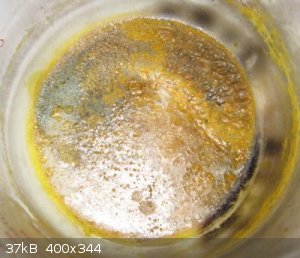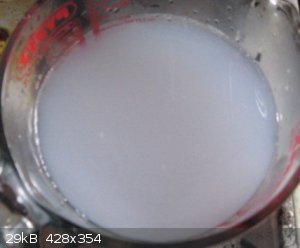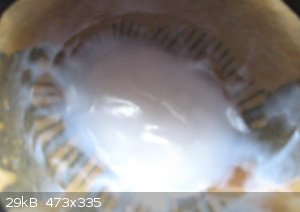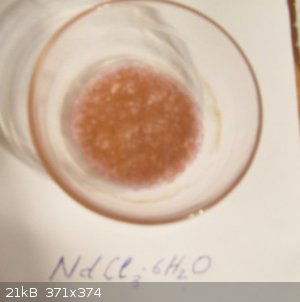| Pages:
1
..
22
23
24 |
SantinoCase
Harmless

Posts: 1
Registered: 7-9-2019
Member Is Offline
|
|
Quote: Originally posted by blogfast25  | Due to beaker breakage the investigation into the presence of Pr had to be abandoned (evidence lost!). Shame.
Below is another pic of the suspected mix of FeCl3 and PrCl3, with prominent green patches between 10 and 11 o'clock:

Nd(OH)3.n H2O suspension about to be filtered, nice lavender colour:

Nd(OH)3.n H2O on the filter:

NdCl3.6 H2O (photo distorts colour), after dissolving Nd(OH)3 in HCl, crystallizing, washing with acetone and drying. Predictably perhaps, when viewed
under a 'saver bulb' it takes on a decidedly greenish hue!

|
Hi Same thing here, I think I need some stronger beakers.
Did you give it another try?
|
|
|
BauArf56
Hazard to Self
 
Posts: 68
Registered: 22-8-2019
Location: between the moon and the sun
Member Is Offline
Mood: energetic
|
|
I tried the extraction with another method. I place some crushed magnet (with nickel cover) in a copper sulfate solution. After some hour solution
turn green. In this solution should be ferric sulfate, nickel sulfate and neodymium sulfate. I add some potassium exacyanoferrate and turned dark red
(nickel exacyanoferrate, i think). I filtered and the liquid should contain Nd2(SO4)3. Added sodium hydroxide and solution turn light blue. Is it
neodymium hydroxide?
|
|
|
Lion850
National Hazard
   
Posts: 517
Registered: 7-10-2019
Location: Australia
Member Is Offline
Mood: Great
|
|
Possible way to separate the dissolved sulfates: Neodymium sulfate solubility in water drops off greatly as the water get need 100 C. This causes the
neodymium sulfate to precipitate out near boiling point and it can then be filtered out by filtering the near boiling solution.
|
|
|
Bezaleel
Hazard to Others
  
Posts: 444
Registered: 28-2-2009
Member Is Offline
Mood: transitional
|
|
One of the problems with heating the solution to precipitate the RE sulfates is co-precipitation of other cations. Adding oxalic acid has
traditionally been a successful method which largely avoids this.
|
|
|
elementcollector1
International Hazard
    
Posts: 2684
Registered: 28-12-2011
Location: The Known Universe
Member Is Offline
Mood: Molten
|
|
Decided to revisit this after... however many years it's been. Now that I have a job with access to a TGA (and various other scientific equipment), I
wondered what the minimum possible temperature to go about the oxalate route was.
Turns out it's a lot lower than I expected - you can achieve satisfactory results at just 200 C. That's kitchen oven temperatures!
Full writeup is here- I wrote it like a paper because it's technically a sequel to my long-ago college term paper on neodymium recycling.
Elements Collected:52/87
Latest Acquired: Cl
Next in Line: Nd
|
|
|
elementcollector1
International Hazard
    
Posts: 2684
Registered: 28-12-2011
Location: The Known Universe
Member Is Offline
Mood: Molten
|
|
Checked some more literature and found my conclusions are wrong - neodymium oxalate's stable carbonate intermediary is the decomposition reaction
between 400 and 800 C, not the one between 150 and 300 C - that one is actually the last water of hydration leaving the oxalate and any
ferric oxalate present decomposing to ferrous oxalate. This explains why I continue to find iron present in the mixture after this reaction step and
the triferrioxalate step - evidently there was still some undissolved ferric or unreacted ferrous oxalate still present. I used significantly more
than the stoichiometric amount of oxalic acid (as well as lots and lots of water) to get the triferrioxalate to dissolve, but this wasn't enough?
Either that, or the hydrogen peroxide and sulfuric acid added to the earlier 'magnet sulfate' solution didn't go all the way to ferric sulfate.
However, this does open up a new and much easier pathway to iron/neodymium separation, even if it doesn't fit within my original concept of only using
kitchen oven temperatures - ferrous oxalate decomposes completely between 300 and 400 C, so heating the mixture to 400 for a few hours and then
washing with sulfuric acid should remove the last traces of iron to leave a pure neodymium oxalate, which can then be decomposed easily at higher
temperatures.
Referenced paper DOI's are here if anyone wants to read them:
10.1002/zaac.19633240110
10.1007/bf01113573
Elements Collected:52/87
Latest Acquired: Cl
Next in Line: Nd
|
|
|
Bezaleel
Hazard to Others
  
Posts: 444
Registered: 28-2-2009
Member Is Offline
Mood: transitional
|
|
Very interesting, elemntcollector1!
Separating Nd from magnets is one of the first experiments I did when I started to do experiments again after I stopped doing so as a teenager. My
conclusion back then was that the Nd in the magnets was impure because not all Pr had been removed from the Nd before the magnets were made. In a
search I found that in order to get a strong magnet, not all Pr needs to be removed.
Do I understand you correctly that you found that the brown colour of the assumed Nd2O3 after calcination is due to the presence of iron compounds?
|
|
|
elementcollector1
International Hazard
    
Posts: 2684
Registered: 28-12-2011
Location: The Known Universe
Member Is Offline
Mood: Molten
|
|
Quote: Originally posted by Bezaleel  |
Do I understand you correctly that you found that the brown colour of the assumed Nd2O3 after calcination is due to the presence of iron compounds?
|
That's correct. I also noted that increased temperature resulted in a more red-brown color typical of Fe2O3, while holding at 400 resulted in a more
'yellow' color (either partial Fe2O3 or 'yellow iron oxide' FeO(OH).H2O - unlikely to be the latter at 400 C, since all water of hydration should be
long gone).
No data yet on mass loss between 400 and 800 C calcinations, but an easy way to check this assumption would be to run a longer 400 C decomposition to
see if the color eventually matches the 800 C run.
Elements Collected:52/87
Latest Acquired: Cl
Next in Line: Nd
|
|
|
Colleen Ortiz
Harmless

Posts: 19
Registered: 16-12-2021
Member Is Offline
|
|
The chemical element neodymium has the symbol Nd and the atomic number 60. It is the fourth element in the lanthanide series and is typically regarded
as a rare-earth metal. It is a silvery, hard, relatively malleable metal that tarnishes swiftly in air and moisture. In the +2, +3, and +4 oxidation
states, neodymium reacts swiftly to form pink, purple/blue, and yellow compounds. It is often considered as having one of the most complicated
elemental spectra. Carl Auer von Welsbach, an Austrian scientist who initially found praseodymium, discovered neodymium in 1885. It may be found in
substantial amounts in the ore minerals monazite and bastnäsite. Neodymium is seldom discovered in its pure metallic state or unmixed with other
lanthanides, and it is frequently purified for widespread usage. Neodymium is a reasonably common element, roughly as abundant as cobalt, nickel, or
copper, and is extensively dispersed in the Earth's crust. As with several other rare-earth metals, China mines the majority of the world's commercial
neodymium. Neodymium compounds were first used commercially as glass dyes in 1927, and they are still a common glass addition today. The hue of
neodymium compounds is attributable to the Nd3+ ion and is commonly reddish-purple, although it varies depending on the kind of illumination owing to
the interaction of neodymium's acute light absorption bands with ambient light supplemented with mercury's sharp visible emission bands. Some
neodymium-doped glasses are utilised in infrared lasers with wavelengths ranging from 1047 to 1062 nanometers. These have been employed in extremely
high-power applications, such as inertial confinement fusion studies. In the Nd:YAG laser, neodymium is combined with a variety of different substrate
crystals, including yttrium aluminium garnet. Another notable application for neodymium is as a component in alloys used to create high-strength
neodymium magnets, which are extremely powerful permanent magnets. These magnets are commonly found in items such as microphones, professional
loudspeakers, in-ear headphones, high performance hobby DC electric motors, and computer hard drives, where minimal magnet mass (or volume) or strong
magnetic fields are required. Larger neodymium magnets are utilised in high-power-to-weight electric motors and generators (for example, in hybrid
autos) (for example aircraft).
|
|
|
fusso
International Hazard
    
Posts: 1922
Registered: 23-6-2017
Location: 4 ∥ universes ahead of you
Member Is Offline
|
|
Quick update: I finally converted all insoluble Fe(II) oxalate into soluble ferrioxalate(III) and filtered it away, leaving insoluble Nd oxalate
behind...and now I have to go thru another tedious step of washing out the remaining ferrioxalate without a vacuum filtration set...
[Edited on 220822 by fusso]
|
|
|
Texium
|
Thread Untopped
5-12-2023 at 14:19 |
| Pages:
1
..
22
23
24 |